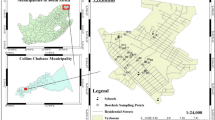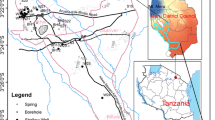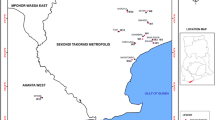Abstract
This study aimed to determine the status of groundwater contamination with faecal coliform and nitrate in the rural areas of Mardan district, Pakistan. Both analytes require regular monitoring according to the National Environmental Quality Standards (NEQS) of Pakistan. Groundwater samples (n = 100) were collected from 25 villages across four zones. Samples were analysed for physicochemical parameters including pH, electrical conductivity (EC), Escherichia coli (E. coli) contamination, nitrite, and nitrate (\({\mathrm{NO}}_{2}^{ - }\) and \({\mathrm{NO}}_{3}^{ - }\)). Whilst the average concentrations of \({\mathrm{NO}}_{3}^{ - }\) in the water samples were within the permissible limits of 50 mg L−1 set by the World Health Organisation (WHO) and NEQS two villages exceeded the safety limits. Non-carcinogenic health risks of \({\mathrm{NO}}_{3}^{ - }\) were estimated in terms of average daily dose (ADD) and hazard quotient (HQ). The HQ values for \({\mathrm{NO}}_{3}^{ - }\) were > 1 for children signifying potential health risks; however, the adult population had HQ < 1 which indicates no risk. Groundwater samples tested positive for E. coli contamination in 13 villages, suggesting that residents may be living at risk of various microbial diseases due to drinking of contaminated water. The findings of this study provide valuable baseline data for groundwater researchers, policymakers, and the local public health department.



Similar content being viewed by others
References
Ahada, C. P., & Suthar, S. (2018). Groundwater nitrate contamination and associated human health risk assessment in southern districts of Punjab, India. Environmental Science and Pollution Research, 25, 25336–25347.
Alimohammadi, M., Latifi, N., Nabizadeh, R., Yaghmaeian, K., Mahvi, A., H., Yousefi, M. , et al. (2018). Determination of nitrate concentration and its risk assessment in bottled water in Iran. Data in Brief, 19, 2133–2138.
Ali, S. M. (2014). A review on contamination and leaching of nitrate in the ground water. International Journal of Physical and Social Sciences, 4, 491–501.
Arshad, N., & Imran, S. (2017). Assessment of arsenic, fluoride, bacteria, and other contaminants in drinking water sources for rural communities of Kasur and other districts in Punjab, Pakistan. Environmental Science and Pollution Research, 24, 2449–2463.
Azizullah, A., Khattak, M. N. K., Richter, P., & Häder, D.-P. (2011). Water pollution in Pakistan and its impact on public health—a review. Environment International, 37, 479–497.
Bain, R., Cronk, R., Hossain, R., Bonjour, S., Onda, K., Wright, J., et al. (2014). Global assessment of exposure to faecal contamination through drinking water based on a systematic review. Tropical Medicine and International Health, 19, 917–927.
Darzi-Naftchali, A., Shahnazari, A., & Karandish, F. (2017). Nitrogen loss and its health risk in paddy fields under different drainage managements. Paddy and Water Environment, 15, 145–157.
Daud, M. K., Nafees, M., Ali, S., Rizwan, M., Bajwa, R. A., Shakoor, M. B., et al. (2017). Drinking water quality status and contamination in Pakistan. BioMed Research International, 2017, 1–18.
Díaz-Somoano, M., Kylander, M. E., López-Antón, M. A., Suárez-Ruiz, I., Martínez-Tarazona, M. R., Ferrat, M., et al. (2009). Stable lead isotope compositions in selected coals from around the world and implications for present day aerosol source tracing. Environmental Science and Technology, 43, 1078–1085.
GoP (Government of Pakistan). (2014). Development Statistics of Khyber Pakhtunkhwa 2014. http://www.freshwateraction.net/sites/freshwateraction.net/files/Drinking%20water%20in%20Pakistan.pdf. Accessed July 2020.
Gul, N., Shah, M. T., Khan, S., Khattak, N.U. & Muhammad, S. (2015). Arsenic and heavy metals contamination, risk assessment and their source in drinking water of the Mardan District, Khyber Pakhtunkhwa, Pakistan. Journal of Water and Health, 13, 1073–1084.
Hisam, A., Rahman, M. U., Kadir, E., Tariq, N. A., & Masood, S. (2014). Microbiological contamination in water filtration plants in Islamabad. Journal of College of Physician and Surgeons Pakistan, 24, 345–350.
Hussain, J., Jehangir, S., Wahid, H., Ali, R., Sousa, L., Lopes, W., et al. (2012). Evaluation of the quality of drinking water of Mardan District, KPK, Pakistan. American-Eurasian Journal of Agricultural & Environmental Sciences, 12, 1047–1051.
Islam, M. S., Mahmud, Z. H., Islam, M. S., Saha, G. C., Zahid, A., Ali, A. Z., et al. (2016). Safe distances between groundwater-based water wells and pit latrines at different hydrogeological conditions in the Ganges Atrai floodplains of Bangladesh. Journal of Health, Population and Nutrition, 35, 26.
Jabeen, S., Mahmood, Q., Tariq, S., Nawab, B., & Elahi, N. (2011). Health impact caused by poor water and sanitation in district Abbottabad. Journal of Ayub Medical College Abbottabad, 23, 47–50.
Kausar, R., & Ahmad, Z. (2009). Determination of toxic inorganic elements pollution in ground waters of Kahuta Industrial Triangle Islamabad, Pakistan using inductively coupled plasma mass spectrometry. Environmental Monitoring and Assessment, 157, 347.
Khan, S., Shahnaz, M., Jehan, N., Rehman, S., Shah, M. T., & Din, I. (2013). Drinking water quality and human health risk in Charsadda district, Pakistan. Journal of Cleaner Production, 60, 93–101.
Knobeloch, L., Salna, B., Hogan, A., Postle, J., & Anderson, H. (2000). Blue babies and nitrate-contaminated well water. Environmental Health Perspectives, 108, 675–678.
Kundu, M. C., Mandal, B., & Hazra, G. C. (2009). Nitrate and fluoride contamination in groundwater of an intensively managed agroecosystem: a functional relationship. Science of the Total Environment, 407, 2771–2782.
Melo, A., Pinto, E., Aguiar, A., Mansilha, C., Pinho, O., & Ferreira, I. M. (2012). Impact of intensive horticulture practices on groundwater content of nitrates, sodium, potassium, and pesticides. Environmental Monitoring and Assessment, 184, 4539–4551.
Memon, M., Soomro, M. S., Akhtar, M. S., & Memon, K. S. (2011). Drinking water quality assessment in Southern Sindh (Pakistan). Environmental Monitoring and Assessment, 177, 39–50.
Nawab, J., Khan, S., Ali, S., Sher, H., Rahman, Z., Khan, K., et al. (2016). Health risk assessment of heavy metals and bacterial contamination in drinking water sources: a case study of Malakand Agency, Pakistan. Environmental Monitoring and Assessment,, 188, 286.
Qayyum, M., Rehman, R., Ahmad, B., Ahmad, M., Ali, S. & Murtaza, S. (2013). Statistical analysis of fluoride levels in human urine and drinking water samples of fluorinated area of Punjab (Pakistan). Journal of the Chemical Society of Pakistan, 34.
Rice, E. W., Baird, R. B., Eaton, A. D., & Clesceri, L. S. (2012). Standard methods for the examination of water and wastewater. Washington, DC: American Public Health Association.
Sadler, R., Maetam, B., Edokpolo, B., Connell, D., Yu, J., Stewart, D. et al. (2016). Health risk assessment for exposure to nitrate in drinking water from village wells in Semarang, Indonesia. Environmental Pollution, 216, 738–745.
Su, X., Wang, H., & Zhang, Y. (2013). Health risk assessment of nitrate contamination in groundwater: a case study of an agricultural area in Northeast China. Water Resources Management, 27, 3025–3034.
Suthar, S., Bishnoi, P., Singh, S., Mutiyar, P. K., Nema, A. K., & Patil, N. S. (2009). Nitrate contamination in groundwater of some rural areas of Rajasthan, India. Journal of Hazardous Materials, 171, 189–199.
Taneja, P., Labhasetwar, P., & Nagarnaik, P. (2019). Nitrate in drinking water and vegetables: intake and risk assessment in rural and urban areas of Nagpur and Bhandara districts of India. Environmental Science and Pollution Research, 26, 2026–2037.
USEPA (United States Environmental Protection Agency). (1991). Nitrate; CASRN 14797–55–8. https://cfpub.epa.gov/ncea/iris/iris_documents/documents/subst/0076_summary.pdf. Accessed June 2020.
USEPA (United States Environmental Protection Agency). (2002a). Child-specific exposure factors handbook. National Center for Environmental Assessment, Washington, DC; EPA/600/P-00/002B.
USEPA (United States Environmental Protection Agency). (2002b). Method 1103.1: Escherichia coli (E. coli) in water by membrane filtration using membrane-thermotolerant Escherichia coli agar (mTEC).
USEPA (United States Environmental Protection Agency). (2014). Escherichia coli (E. coli) in water by membrane filtration using modified membrane-thermotolerant Escherichia coli agar (modified mTEC). Washington DC: United States Environmental Protection Agency.
Vystavna, Y., Diadin, D., Grynenko, V., Yakovlev, V., Vergeles, Y., Huneau, F., et al. (2017). Determination of dominant sources of nitrate contamination in transboundary (Russian Federation/Ukraine) catchment with heterogeneous land use. Environmental Monitoring and Assessment, 189, 509.
Ward, M. H., Jones, R. R., Brender, J. D., de Kok, T. M., Weyer, P. J., Nolan, B. T., et al. (2018). Drinking water nitrate and human health: an updated review. International Journal of Environmental Research and Public Health, 15, 1557.
WHO (World Health Organisation). (1997). Guidelines for drinking-water quality: Volume 3 - surveillance and control of community supplies, 2nd ed. Geneva: World Health Organisation.
WHO (World Health Organisation). (2011). Guidelines for drinking-water quality (4th ed.). Geneva: World Health Organisation.
WHO (World Health Organisation). (2013). Water quality and health strategy 2013–2020. https://www.who.int/water_sanitation_health/publications/water_quality_strategy/en/. Accessed July 2020.
WHO (World Health Organisation). (2018). Guidelines on sanitation and health. https://www.who.int/water_sanitation_health/publications/guidelines-on-sanitation-and-health/en/. Accessed July 2020.
Wick, K., Heumesser, C., & Schmid, E. (2012). Groundwater nitrate contamination: factors and indicators. Journal of Environmental Management, 111, 178–186.
Zaman, S. 2008. National Standards for Drinking Water Quality. Government of Pakistan Environmental Protection Agency Ministry of Environment. http://www.freshwateraction.net/sites/freshwateraction.net/files/Drinking%20water%20in%20Pakistan.pdf. Accessed July 2020.
Zhang, Q., Wang, H., Wang, Y., Yang, M., & Zhu, L. (2017). Groundwater quality assessment and pollution source apportionment in an intensely exploited region of northern China. Environmental Science and Pollution Research, 24, 16639–16650.
Zissimos, A. M., Christoforou, I. C., Morisseau, E., Cohen, D. R., & Rutherford, N. F. (2014). Distribution of water-soluble inorganic ions in the soils of Cyprus. Journal of Geochemical Exploration, 146, 1–8.
Acknowledgements
The authors are grateful to Dr Michael Watts (British Geological Survey) for his useful feedback on the manuscript.
Funding
Funding for this project was provided by the Higher Education Commission, Pakistan under International Research Support Initiative Programme (IRSIP 35 BMS 20).
Author information
Authors and Affiliations
Contributions
ZR, SA, RF, SK, IA, OSH, HK, and BK conceived the research idea and designed the experiments. ZR and SA collected and processed the samples. ZR, RF, and BK analysed the samples. ZR, SA, RF, SK, IA, OSH, HK, and BK processed and analysed the data. ZR wrote the manuscript with support and feedback from all the authors.
Corresponding author
Ethics declarations
Conflict of Interest
The authors declare that they have no conflict of interest.
Availability of data and material
The authors confirm that the summary of data supporting the findings of this study is available within the article. However, detailed data of this study are available from the corresponding author upon request.
Code availability
Not applicable
Ethics approval
Not applicable
Consent to participate
Not applicable
Consent for publication
Not applicable
Additional information
Publisher's Note
Springer Nature remains neutral with regard to jurisdictional claims in published maps and institutional affiliations.
Rights and permissions
About this article
Cite this article
Rahman, Z.u., Ahmad, S., Fidel, R. et al. Faecal and nitrate contamination in the groundwater of Mardan district, Pakistan. Environ Geochem Health 43, 3615–3624 (2021). https://doi.org/10.1007/s10653-021-00848-8
Received:
Accepted:
Published:
Issue Date:
DOI: https://doi.org/10.1007/s10653-021-00848-8




